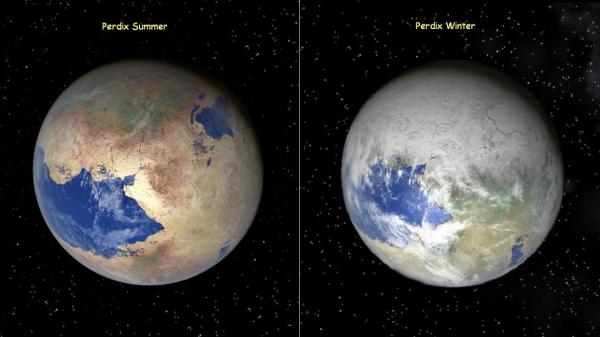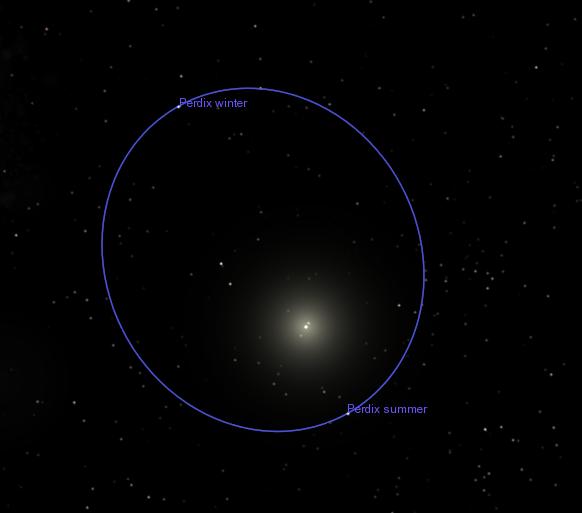BY LETTER
Perdix
Galactography > Regions of Space > Middle Regions/Hinter-regions
Galactography > Systems and Worlds > Systems & Worlds O - P
Galactography > Systems and Worlds > Systems & Worlds O - P
Terraformed terrestrial world in an eccentric orbit | |
 Image from Steve Bowers | |
| The hot season on Perdix is short, but fierce; the winter, on the other hand, is long, and very cold. | |
Perdix - Data Panel | |
| Star | HIP 30050 |
|---|---|
| Type | F7v |
| Luminosity | 2.38 x Sol |
| Distance from Sol | 259 ly |
| Planet | Perdix |
| Nolwocs Classification | Ikarian subtype (Gaian world in an eccentric orbit) |
| Semimajor axis | 1.54AU |
| Year | 1.69 standard years |
| Eccentricity | 0.44 |
| Obliquity | 11 degrees |
Colonisation
Perdix was settled by a House Genen mission in 3010 AT. The world was dry, and in a highly eccentric orbit, with a significant but temporary increase in surface temperature as the planet approached the local star at periastron. The Genen ecomasters embarked on a long campaign of terraformation, bombarding the inconstant planet with icy objects from the outer system. This process (it was hoped) would create larger oceans on this dry world, creating a heat reservoir on the surface to absorb warmth in the brief, bakingly hot periaston summer and release it during the long, slow apastron winter. In practice the increase in water vapour in the atmosphere caused a significant greenhouse effect, making the winters somewhat warmer, and the summer humid, and even hotter than before. Most important of all, the wet atmosphere caused prolonged and heavy snowfall in high latitudes on this world in both hemispheres, creating a thick but temporary snow cover which would completely melt every year in almost all locations across the globe.The Genen redesigned themselves to fit into this ever-changing environment; the result was a roughly humanoid, knuckle-walking quadruped, with a seasonal coat which they lose every summer. In the depths of winter the Perdician population can hibernate beneath the snow for several months, although their larger towns and cities were designed to continue to operate beneath the ten-metre thick snow cover that falls every year. In the short summer, the snow cover melts and sublimes, watering the terraced fields and agricultural plains for the first growing season, a hundred and twenty local days long.
Current Climate
After the early attempt at terraformation, the climate of Perdix settled down into a cycle of seasons which has persisted to this day. As the planet draws near to the local star, the water content of the atmosphere increases, replacing the snowclouds of winter with high convection clouds filled with rain.; as the temperature continues to increase after periastron due to thermal inertia in the atmosphere, the clouds ride ever higher until they become a thin, high, haze barely hiding a blazing, swollen sun. At this point the rivers and lakes become dry and mud-caked, sometimes even boiling away. The now-hairless Perdician natives often bury themselves in the mudlakes, breathing through a trunk-like nose. Once again the larger towns and cities protect themselves against the hot season, beneath large cooling tanks of melted snow-water on every roof. But even the largest towns are surrounded by extensive mudlakes where the majority of the population aestivate for a month or so in late summer.After the hot season the rains return for a second growing season, increasingly turning to snow as the planet gets further from the star. Because the tilt of this planet is small, the north and south hemispheres experience roughly the same seasons at the same time; the regions around the equator are generally much hotter in summer and less cold in winter than the regions towards the poles. A large desert occupies the centre of the largest continent, but this region, free from heavy snow, is extensively irrigated.
The Early Colony; every season a fresh start
Over time, Perdician culture has been shaped by the four seasons of this world of extremes; the first growing season, followed by a short aestivation, followed by a second growing season and finally a period of hibernation. The disjointed nature of their existence affected the early colony profoundly. The Perdicians would awake each growing season with a new perspective, many of their past memories and experiences hazy and half-forgotten. This meant that they would start each season with a relatively blank slate, forming new friendships and alliances, new attitudes and even entirely new belief systems on each awakening. The Genen families found that this ever-changing social dynamic led to a constantly changing society, with a constant turn-over of political and philosophical attitudes and beliefs.But such a constantly changing dynamic meant that the old practices were often disregarded, and a large section of the population began to live in protected homes and cities beneath the snow or mud. Even in the permanent habitats the mercurial Perdician nature tends to assert itself, and sections of the urban population would periodically migrate out to live in the cold and heat of the wilds joining those who live there permanently.
The Dreamers
A particularly important development in the 7th millennium was the introduction of a particularly popular corporate virtual dream environment, which could be accessed during hibernation and aestivation by Perdician citizens. Over time this environment increased in importance and complexity, until for many dreamers the virtual environment became more important than the waking reality.The Undergrounders
A significant number of citizens (mostly Dreamers) have in recent times progressed to superior toposophic status, then to the first singularity and beyond. Some use Genen biotechnology to become radically changed transapient entities, while others use other forms of computronium technology. Some of these transapient entities remain half-buried in the soils of Perdix, sheltered from the heats and colds of this intemperate planet, serviced by crews of biological or mechanical servants and avatars. Image from Steve Bowers | |
| The seasons on Perdix are caused by its eccentric orbit | |
Related Articles
Appears in Topics
Development Notes
Text by Steve Bowers
Initially published on 28 September 2009.
Initially published on 28 September 2009.






